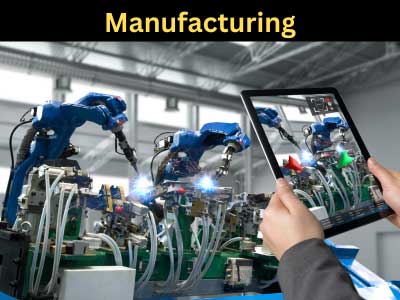Key Takeaway
Collaborative robots (cobots) offer significant benefits in manufacturing by working alongside humans to enhance productivity. Cobots are easy to program and install, making them flexible for various applications. They improve accuracy, speed, and consistency in tasks, outperforming human capabilities in repetitive and precision-driven work.
Cobots also enhance workplace safety by handling dangerous tasks, allowing human workers to focus on more complex activities. Their ability to adapt quickly to different tasks makes them ideal for industries requiring frequent changes in production processes. Overall, cobots boost efficiency, reduce error rates, and improve overall manufacturing performance.
Overview of Automation Software in Manufacturing
Manufacturing automation software plays a pivotal role in modern production environments, streamlining operations, enhancing productivity, and reducing human error. It has evolved to encompass various functions, from controlling machinery and robots on the shop floor to managing complex data streams from sensors and devices. Today’s automation software is highly integrated, often connecting with enterprise systems like ERP (Enterprise Resource Planning) and MES (Manufacturing Execution Systems) to provide a holistic view of the production process. This enables manufacturers to optimize workflows, reduce waste, and increase efficiency. With the continuous advancement of technology, manufacturing automation software is becoming more sophisticated, supporting real-time decision-making and offering greater flexibility in adjusting to market demands. As a result, it has become an essential tool for industries looking to stay competitive in an increasingly digital world.

The Role of AI and Machine Learning in Automation Software
Artificial intelligence (AI) and machine learning (ML) are driving transformative changes in manufacturing automation software. AI-powered software is capable of analyzing vast amounts of data generated by machines, sensors, and systems on the production floor. This allows manufacturers to identify patterns, optimize operations, and make data-driven decisions with precision. For example, AI can help in adjusting machine settings automatically based on real-time data, ensuring optimal performance without human intervention. This capability significantly reduces downtime and increases the overall efficiency of the production process.
Machine learning goes one step further by enabling automation systems to learn from data over time. As these systems gather more information, they can improve their performance, predict potential issues, and recommend improvements. This self-learning ability means that manufacturers can continually optimize processes without manual adjustments, saving time and resources. The integration of AI and ML into automation software empowers companies to embrace smart manufacturing, where processes are more agile, adaptable, and resilient in the face of market changes or operational challenges.
Cloud-Based Solutions for Automation Management
Cloud-based automation software is revolutionizing how manufacturers manage their operations. Traditional automation systems were often limited by on-premise hardware, requiring significant investments in infrastructure and IT support. Cloud-based solutions offer a more flexible and scalable alternative, allowing manufacturers to access automation tools and data from anywhere, at any time. This is particularly useful for global companies with multiple production sites, as cloud platforms enable real-time collaboration and centralized control across different locations.
Moreover, cloud-based automation solutions reduce the need for extensive capital expenditures on physical hardware, as many cloud providers offer subscription-based services that are easy to scale as business needs change. This flexibility ensures that manufacturers can quickly adapt to fluctuations in demand without significant downtime or additional costs. Additionally, cloud platforms provide enhanced data security, automatic updates, and easier integration with other systems, such as ERP or MES software. The result is a streamlined, more connected approach to managing manufacturing operations, ensuring smoother processes and greater agility in responding to challenges.
Real-Time Monitoring and Control with Automation Software
Real-time monitoring and control are becoming indispensable features of modern manufacturing automation software. By providing immediate insights into the performance of machines, production lines, and overall operations, manufacturers can make quick adjustments to avoid downtime, defects, or inefficiencies. With real-time data, managers can track key performance indicators (KPIs) such as equipment utilization, output quality, and cycle times, enabling them to respond proactively to any deviations from optimal performance.
Incorporating real-time monitoring systems into automation software also facilitates better decision-making at every level. Operators on the shop floor can instantly see where problems are occurring, while higher-level management can use this data to identify trends and long-term inefficiencies. Some systems even enable remote control, allowing users to manage and adjust production processes from anywhere, ensuring consistent oversight. These capabilities not only improve productivity but also enhance quality control, as potential issues are identified and resolved quickly, preventing costly rework or scrap.
Predictive Maintenance and Automation Software Integration
One of the most valuable trends in automation software is the integration of predictive maintenance capabilities. By using advanced analytics and machine learning algorithms, predictive maintenance tools can analyze data from machines to identify signs of wear and potential failures before they happen. This allows manufacturers to perform maintenance activities only when necessary, reducing unplanned downtime and extending the life of equipment.
Automation software that incorporates predictive maintenance can monitor parameters such as vibration, temperature, and operational speed in real time. When deviations from the norm are detected, the system alerts maintenance teams to take action before a breakdown occurs. This proactive approach reduces costly disruptions to production and ensures that machinery operates at peak efficiency. In addition to minimizing downtime, predictive maintenance helps companies reduce maintenance costs by preventing unnecessary repairs and optimizing the use of spare parts. As predictive maintenance becomes more integrated with automation software, manufacturers will be able to achieve greater operational resilience and cost savings.
Conclusion
The future of manufacturing automation software is bright, driven by the rapid adoption of AI, cloud technologies, and predictive analytics. As manufacturers continue to embrace digital transformation, automation software will become more intelligent, flexible, and responsive, enabling businesses to optimize their processes like never before. The integration of real-time monitoring, predictive maintenance, and cloud-based solutions will provide manufacturers with unparalleled control and visibility over their operations, reducing waste, improving efficiency, and increasing profitability. With these advancements, the manufacturing industry is poised to become more agile, data-driven, and resilient, positioning companies for success in an increasingly competitive global market.
